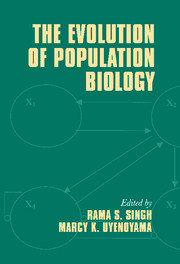Book contents
- Frontmatter
- Contents
- List of contributors
- Publications of R. C. Lewontin
- Preface
- Introduction
- Part I Historical foundations and perspectives
- Part II Genotypes to phenotypes: new genetic and bioinformatic advances
- Part III Phenotypes to fitness: genetics and ecology of populations
- 7 Density-dependent selection
- 8 Nonsynonymous polymorphisms and frequency-dependent selection
- 9 Why k = 4Nus is silly
- 10 Inferences about the structure and history of populations: coalescents and intraspecific phylogeography
- 11 The population genetics of life-history evolution
- 12 Gene–environment complexities: what is interesting to measure and to model?
- 13 Genus–specific diversification of mating types
- Part IV Genes, organisms, and environment: evolutionary case studies
- Part V Applied population biology: biodiversity and food, disease, and health
- Index
10 - Inferences about the structure and history of populations: coalescents and intraspecific phylogeography
Published online by Cambridge University Press: 08 January 2010
- Frontmatter
- Contents
- List of contributors
- Publications of R. C. Lewontin
- Preface
- Introduction
- Part I Historical foundations and perspectives
- Part II Genotypes to phenotypes: new genetic and bioinformatic advances
- Part III Phenotypes to fitness: genetics and ecology of populations
- 7 Density-dependent selection
- 8 Nonsynonymous polymorphisms and frequency-dependent selection
- 9 Why k = 4Nus is silly
- 10 Inferences about the structure and history of populations: coalescents and intraspecific phylogeography
- 11 The population genetics of life-history evolution
- 12 Gene–environment complexities: what is interesting to measure and to model?
- 13 Genus–specific diversification of mating types
- Part IV Genes, organisms, and environment: evolutionary case studies
- Part V Applied population biology: biodiversity and food, disease, and health
- Index
Summary
Introduction
Population geneticists and phylogeneticists view tree structures differently. To the phylogeneticist, tree structures are the objects of study and the branching patterns a tree displays are inherently significant. Phylogeneticists are interested in the relationships among species or other taxa, and these histories are tree-like structures. To the population geneticist, particularly to the student of coalescent theory, individual tree structures are usually not of interest. Instead attention is focused on the characteristics of populations or species, and intraspecific trees, or gene genealogies, are a stepping stone on the path to such knowledge. This difference in approach divides workers who study current and historical population structure into two groups: those who ascribe significance to single gene trees and those who focus on summary properties of gene trees over many loci. The purpose of this chapter is to give some perspective on this division and to suggest ways of identifying the domain of application of coalescents and intraspecific phylogeography in terms of the histories of populations or species. This is not meant to be divisive. In the not too distant future, we can hope that these complementary approaches will be unified, as models catch up with data and a science of population genomics is realized.
- Type
- Chapter
- Information
- The Evolution of Population Biology , pp. 193 - 215Publisher: Cambridge University PressPrint publication year: 2004
- 6
- Cited by

